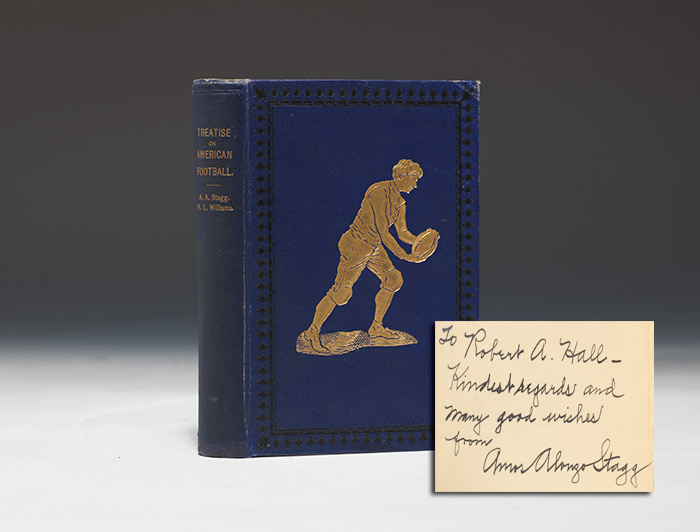
"UNQUESTIONABLY ONE OF THE GREAT FIGURES IN THE HISTORY OF FOOTBALL": SCIENTIFIC AND TACTICAL TREATISE ON AMERICAN FOOTBALL FOR SCHOOLS AND COLLEGES, 1893, INSCRIBED BY AMOS ALONZO STAGG
STAGG, Amos Alonzo and WILLIAMS, Henry L. A Scientific and Practical Treatise on American Football for Schools and Colleges. Hartford, Connecticut: Case, Lockwood & Brainard, 1893. 12mo, original blue cloth, gilt vignette on front cover. $4800.
Scarce first edition of one of the first and most important works on American football, with numerous play diagrams, inscribed by the author to noted Yale football coach Robert Hall: "To Robert A. Hall—Kindest regards and many good wishes from Amos Alonzo Stagg."
"Stagg coached football, as well as baseball and track, at the University of Chicago for 40 years, until he was forced to retire at the age of seventy in 1932. His contributions to athletics in general and football in particular will probably never be matched. He was Chicago's faculty representative to the Big Ten for 15 years and served on the first rules committee of the National Collegiate Athletic Association (NCAA). He was on every American Olympic committee from 1902 to 1932 and was a track coach for the 1924 Olympic team. Stagg is unquestionably one of the great figures in the history of football. At Chicago he had four undefeated seasons and seven Big Ten titles, won 255 games, and trained 11 All Americas. He was a prolific inventor of plays and a master strategist. His alleged innovations include the center snap, the man in motion, the onside kick, the T formation, the hidden ball trick, the place kick, the fake punt, the Statue of Liberty play, and various backfield shifts. He also designed the tackling dummy and was the first coach to have lights installed on the practice field. Moreover, he wrote the first book on football that used diagrams to outline plays.
His other 'firsts' include the implementation of wind sprints in practice, the use of hip pads in uniforms and numbers on players' jerseys, and the awarding of letters to outstanding performers. In addition, he designed troughs for the overflow of swimming pools and the indoor batting cage for baseball" (ANB). Co-author Williams was a legendary coach at the University of Minnesota and another of the game's great innovators. He was the "inventor of the famous tackle-back offense. In 1891, he used it to give Army its first-ever victory over archrival Navy. Williams was a teacher at Siglar Academy in Newburgh, New York, ten miles north of West Point, when he began making twice-weekly trips to the Army campus in order to coach the Cadet varsity… Williams later enrolled in Penn's School of Medicine, paying his way while acting as football and track coach at William Penn Charter School. He then moved to Minnesota and began building outstanding Gopher teams, including his own Minnesota shift, the fore-runner of the Notre Dame shift made famous by Knute Rockne. Williams played football at Yale 1887-1890. He was on a team with Amos Alonzo Stagg, Bum McClung, Pa Corbin and Pudge Heffelfinger, all of whom made the Hall of Fame as players" (National Football Foundation). Without very rare original dust jacket. Ownership signature of inscribee Robert A.Hall with the notation "Yale 1930." Hall was "a prominent college football figure and former athletic director at Yale. Hall was a founder and longtime director of the National Football Foundation and the College Hall of Fame. He had been a Yale quarterback and later a scout for the varsity team while attending Yale Law School. He had been the radio broadcaster for Philadelphia Eagles games. That led to the founding of Tel-Ra, a film company that produced a syndicated college football highlight show for television, with Hall and Harry Wismer as the announcers. Hall was athletic director at Yale from 1950 to 1953. During that time, he headed the television committee of the National Collegiate Athletic Association, which began an embargo of the local televising of games not sold out in home stadiums. The National Football League later adopted the policy" (New York Times obituary).
Interior fine; front free endpaper renewed. Light expert restoration to foot of spine, cloth extremities lightly rubbed, gilt bright. A near-fine copy with exceptional provenance.